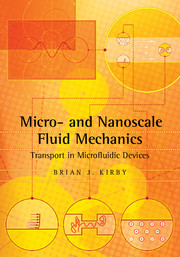Book contents
- Frontmatter
- Contents
- Preface
- Nomenclature
- Introduction
- 1 Kinematics, Conservation Equations, and Boundary Conditions for Incompressible Flow
- 2 Unidirectional Flow
- 3 Hydraulic Circuit Analysis
- 4 Passive Scalar Transport: Dispersion, Patterning, and Mixing
- 5 Electrostatics and Electrodynamics
- 6 Electroosmosis
- 7 Potential Fluid Flow
- 8 Stokes Flow
- 9 The Diffuse Structure of the Electrical Double Layer
- 10 Zeta Potential in Microchannels
- 11 Species and Charge Transport
- 12 Microchip Chemical Separations
- 13 Particle Electrophoresis
- 14 DNA Transport and Analysis
- 15 Nanofluidics: Fluid and Current Flow in Molecular-Scale and Thick-EDL Systems
- 16 AC Electrokinetics and the Dynamics of Diffuse Charge
- 17 Particle and Droplet Actuation: Dielectrophoresis, Magnetophoresis, and Digital Microfluidics
- APPENDIX A Units and Fundamental Constants
- APPENDIX B Properties of Electrolyte Solutions
- APPENDIX C Coordinate Systems and Vector Calculus
- APPENDIX D Governing Equation Reference
- APPENDIX E Nondimensionalization and Characteristic Parameters
- APPENDIX F Multipolar Solutions to the Laplace and Stokes Equations
- APPENDIX G Complex Functions
- APPENDIX H Interaction Potentials: Atomistic Modeling of Solvents and Solutes
- Bibliography
- Index
Introduction
Published online by Cambridge University Press: 05 June 2012
- Frontmatter
- Contents
- Preface
- Nomenclature
- Introduction
- 1 Kinematics, Conservation Equations, and Boundary Conditions for Incompressible Flow
- 2 Unidirectional Flow
- 3 Hydraulic Circuit Analysis
- 4 Passive Scalar Transport: Dispersion, Patterning, and Mixing
- 5 Electrostatics and Electrodynamics
- 6 Electroosmosis
- 7 Potential Fluid Flow
- 8 Stokes Flow
- 9 The Diffuse Structure of the Electrical Double Layer
- 10 Zeta Potential in Microchannels
- 11 Species and Charge Transport
- 12 Microchip Chemical Separations
- 13 Particle Electrophoresis
- 14 DNA Transport and Analysis
- 15 Nanofluidics: Fluid and Current Flow in Molecular-Scale and Thick-EDL Systems
- 16 AC Electrokinetics and the Dynamics of Diffuse Charge
- 17 Particle and Droplet Actuation: Dielectrophoresis, Magnetophoresis, and Digital Microfluidics
- APPENDIX A Units and Fundamental Constants
- APPENDIX B Properties of Electrolyte Solutions
- APPENDIX C Coordinate Systems and Vector Calculus
- APPENDIX D Governing Equation Reference
- APPENDIX E Nondimensionalization and Characteristic Parameters
- APPENDIX F Multipolar Solutions to the Laplace and Stokes Equations
- APPENDIX G Complex Functions
- APPENDIX H Interaction Potentials: Atomistic Modeling of Solvents and Solutes
- Bibliography
- Index
Summary
Micro- and nanofabricated devices have led to revolutionary changes in our ability to manipulate tiny volumes of fluid or micro- and nanoparticles contained therein. This has led to countless applications for chemical and particulate separation and analysis, biological characterization, sensors, cell capture and counting, micropumps and actuators, high-throughput design and parallelization, and system integration, to name a few areas. Because biological and chemical analysis is typically concerned with molecules and bioparticles with small dimensions (some examples are shown in Fig. 0.1), the tools used to manipulate these objects are naturally of a similar scale, and the developments in micro- and nanofabrication in recent decades has brought engineering tools to a scale that easily matches these objects.
From a fluid-mechanical standpoint, our ability to manufacture micro- and nanoscale devices creates a number of challenges and provides matching opportunities, some of which are denoted schematically in Fig. 0.2. If we focus on liquid-phase devices, which have dominated most bioanalytical applications, shrinking the length scales makes interfacial phenomena and electrokinetic phenomena much more important, and reduces the importance of gravity and pressure. The no-slip boundary condition, safely assumed for macroscopic flows, can be inaccurate when the length scale is small. Although the low-Reynolds-number characteristic of most of these flows eliminates the challenges of nonlinearity in the convective term and the associated difficulty in modeling turbulent flows, we are instead forced to consider the nonlinearity of the source term in the Poisson–Boltzmann equation, nonlinearity of the coupling of electrodynamics with fluid flow, and uncertainty in predicting electroosmotic boundary conditions.
- Type
- Chapter
- Information
- Micro- and Nanoscale Fluid MechanicsTransport in Microfluidic Devices, pp. 1 - 5Publisher: Cambridge University PressPrint publication year: 2010



